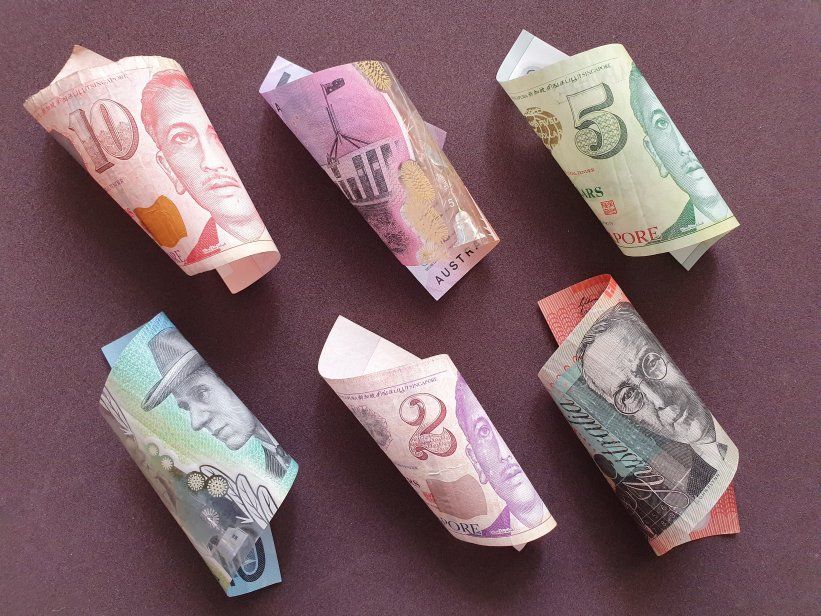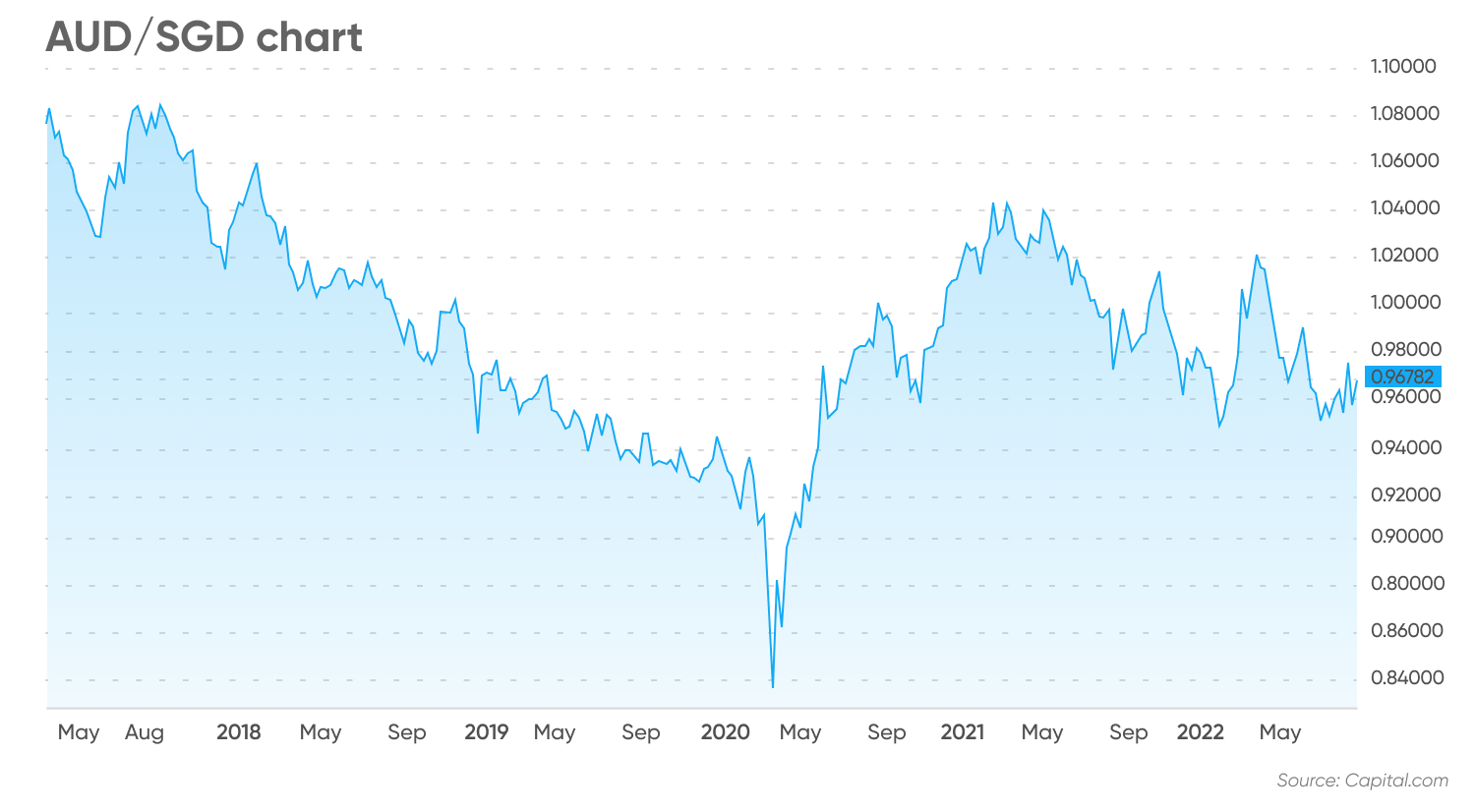AUD/SGD forecast: Can the Aussie move back to parity?
Can the Aussie move back to parity? Read on to learn more.
The Australian dollar (AUD) has been attempting to regain ground against the Singapore dollar (SGD) after sliding below parity earlier this year.
The SGD strengthened in July as the Monetary Authority of Singapore (MAS) adjusted the exchange rate against a basket of currencies in response to rising inflation.
The AUD/SGD exchange rate fell to its lowest level since March 2020. But the Australian dollar has since edged up, supported by expectations of stronger fundamentals later in the year.
What drives the value of the Australian dollar against the Singapore dollar? How do analysts expect the currencies to trade in the future?
In this article, we look at the latest predictions for the AUD/SGD foreign exchange (forex) pair.
What drives the AUD/SGD exchange rate?
The AUD/SGD currency pair represents how many Singapore dollars – the quote currency – you can buy in exchange for one Australian dollar – the base currency.
The Australian dollar, known as the Aussie, is the world’s fifth most traded currency, even though the country's gross domestic product (GDP) is the 12th largest.
The Aussie dollar is often traded as a proxy for the Chinese economy, as China accounts for 36.5% of Australia’s exports. The Aussie is considered to be a commodity currency along with the New Zealand dollar and Canadian dollar. This is because the Australian mining industry accounts for an 11.5% share of the Australian economy and natural resources account for 68.7% of exports.
The Singapore dollar is also strongly influenced by commodity prices, as the city state’s economy is centred on intermediary trade, importing natural resources for refining before export. Singapore’s port is the world's second busiest on cargo tonnage. The city is a regional financial centre.
The MAS controls the value of the Singapore dollar by managing it in a floating band referred to as the Singapore Dollar Nominal Effective Exchange Rate (S$NEER). The S$NEER values the Singapore dollar against a basket of currencies from Singapore’s main trading partners and competitors to manage inflation from imports and maintain the competitiveness of its exports.
In addition to commodity prices, the value of the Australian and Singaporean dollars is influenced by a range of economic data from both countries, including GDP, trade data and employment, as well as monetary policy on interest rates and inflation.
AUD/SGD volatility reflects commodity demand
The AUD/SGD exchange rate fell to 83.86 in March 2020, from 93.80 at the end of 2019, as the Aussie weakened at the start of the Covid-19 pandemic. AUD rebounded later in the year, reaching parity in August 2020 as the first round of lockdowns eased. The pair slipped to 0.96 in October 2020, but then advanced to 1.0434 in March 2021.

The Aussie was unable to hold on to parity against the Singapore dollar, and traded back down to 0.9727 by mid-August 2020. The pair traded at parity again in October 2021, but fell back in November and traded down to 0.9485 in January this year.
In April, the Australian dollar traded up to 1.0206 – its highest level since May 2021 – as commodity prices rallied in response to the Russian invasion of Ukraine. A retreat in May saw the pair trade down at 0.9583.
The Singapore dollar strengthened in mid-July, when the MAS adjusted the S$NEER in response to high inflation. The AUD/SGD pair traded down to 0.9469 – its lowest level since the March 2020 decline.
The Reserve Bank of Australia (RBA) raised interest rates by 50 basis points on 2 August and is expected to raise them again in its next meeting on 6 September, with inflation at its highest level since the early 1990s.
The AUD/SGD rate has moved up from the lows, trading at 0.9766 on 12 August and around 0.9689 at the time of writing on 25 August.
Inflation to remain key driver
Concerns about high inflation rates in both Australia and Singapore are set to continue leading short-term monetary policy. While the RBA is expected to raise interest rates next month, which would support the value of the Aussie dollar, the MAS is expected to continue lifting the trading band for the Singapore dollar in an attempt to contain inflation.
“Singapore's July inflation rate rose 7% y-o-y as expected while the core inflation rate rose 4.8% YoY, above expectation of 4.7%,” analysts at HSBC noted on 24 August.
Analysts at Australian bank Westpac noted that minutes from the RBA’s August meeting indicated that: “‘The Board expects to take further steps in the process of normalising monetary conditions over the months ahead, but it is not on a pre-set path… Much has been made of the term ‘pre-set path’ and we agree that it signals that at some point the Board will take a shift down in the pace of tightening from 50 basis points per meeting to 25 basis points. However, we believe that shift will not occur in September… Once having reached 2.35% in September it seems likely the Board will lower the pace to 25 basis points.”
The analysts wrote in a weekly client note on 22 August:
What impact does the current environment have on the AUD/SGD forecast for the coming months?
AUD/SGD forecast: How will the pair trade amid persistent high inflation?
Analysts at US-based Citibank noted this week that there are “2 key pillars of support for AUD especially against its peers (NZD, CAD) and the euro bloc (EUR and GBP) – (1) a more resilient Australian growth outlook; and (2) China’s expected recovery later in H2.”
Antti Ilvonen, analyst at Denmark’s Danske Bank, is cautious on the outlook for the Australian dollar, noting: “Rising natural gas prices and high demand for LNG from Europe continue to support Australian terms-of-trade despite the weak growth in China and the consequently declining iron ore prices. While we expect the Reserve Bank of Australia to continue hiking rates after the 50bp hike in the August meeting, the weakening economic growth forces it to take a more meeting-by-meeting approach going forward.
Analysts at SEB Group noted that the Aussie dollar is “strongly driven by commodities & risk assets while the positive beta to global rates is fading… The Aussie is essentially a reflation proxy (expansion regime sweet spot) as it has a positive beta to commodities, equities & rates. The factor sensitivity to equities and commodities are running at historically high levels.
“Commodities and crude oil in particular have traded considerably worse than risk assets since June on the recession narrative, as equities enjoyed a substantial (bear market) rally. This bifurcation is starting to look stretched while the underlying bottom-up fundamentals are somewhat more supportive for commodities & energy going forward: Chinese data is poor but using the credit impulse as a (naïve) forward indicator we have probably seen the worst, and we are approaching the point where we could see more policy support.”
This could provide support for the Australian commodities sector and lift the value of the Aussie dollar.
Analysts at Malaysia-based Maybank were “mildly bearish” on the AUD/SGD pair, as of 19 August, with the bank’s technical analysis indicating support for the rate at 0.9530 and resistance up at 0.9780. The bank’s most recent monthly AUD/SGD forecast on 29 July showed the pair stabilising at 0.96 by the end of the third quarter, slipping to 0.95 by the end of the year but then trading back at 0.96 in the first half of 2023.
Technical analysis by HSBC on 24 August showed support at 0.9480 down to 0.9350, with resistance up at 0.9760 and 0.9900.
At the time of writing (25 August), the Australian dollar to Singapore dollar forecast from Trading Economics predicted that the Singapore dollar could strengthen more than the Aussie dollar over the medium term, with the pair trading at 0.94695 by the end of this quarter and at 0.91848 in one year, according to the data firm’s global macro models projections and analysts’ expectations.
But for the longer term, the AUD/SGD forecast for 2022 from algorithm-based forecasting service Wallet Investor showed the pair stabilising around the 0.96 level, ending the year at 0.9634 and trending higher in the coming years. The site’s AUD/SGD forecast for 2025 showed the pair trading at 1.0257 by the end of the year and reaching 1.0704 in five years’ time.
The Economy Forecast Agency’s AUD/SGD prediction showed the pair rising to 1.038 by the end of 2022 and 1.082 by the end of 2023, slipping back to 0.971 by the end of 2024 before rebounding to 1.026 by the end of 2025. Analysts have yet to issue an AUD/SGD forecast for 2030.
When looking at any AUD/SGD forecast, it’s important to keep in mind that forex markets are highly volatile, making it difficult to make accurate long-term estimates. We recommend that you always do your own research. Look at the latest market trends, news, technical and fundamental analysis, and expert opinion before making any investment decision. Keep in mind that past performance is no guarantee of future returns. And never invest money that you cannot afford to lose.
FAQs
Why has AUD/SGD been rising?
The Australian dollar has bounced up from a two-year low seen in July, when the Monetary Authority of Singapore (MAS) adjusted the Singapore dollar’s exchange rate. The Aussie dollar has found support from rising interest rates and expectations of a recovery in the Chinese economy, a major export destination for the Australia's natural resources.
Will AUD/SGD go up or down?
The direction of the AUD/SGD pair could depend on monetary policy in Australia and Singapore, as the countries’ central banks look to dampen high inflation. Commodities’ prices are also key drivers for both currencies, among other factors.
When is the best time to trade AUD/SGD?
You can trade the AUD/SGD pair around the clock on weekdays. The busiest time for the market is often around the release of economic data or major world events, which can drive volatility.
Is AUD/SGD a buy, sell or hold?
Your trading strategy for the AUD/SGD pair depends on your personal circumstances, risk tolerance and portfolio composition. You should do your own research to develop an informed view of the market.
Look at the latest market trends, news, technical and fundamental analysis, and expert opinion before making any investment decision. Keep in mind that past performance is no guarantee of future returns. And never invest money that you cannot afford to lose.